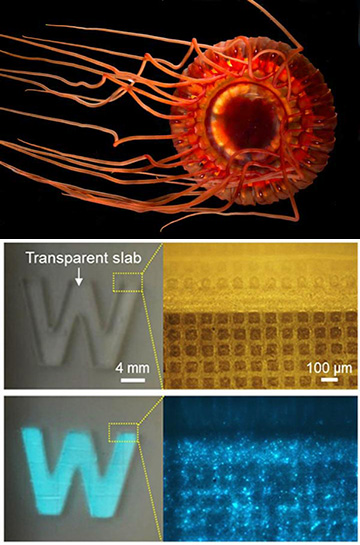
The pressure-sensitive skin of the jellyfish Atolla wyvillei (top) inspired an electronic skin glows when a transparent pattern is pressed onto it (middle) and a voltage is applied (bottom). [Image: NOAA Ocean Exploration & Research/Flickr (top); American Chemical Society (middle and bottom)]
Current electronic-skin designs contain integrated electrical sensors that can detect the slightest touch. However, when it comes to detecting potentially damaging pressure, these sensors fall short. The narrow range of pressure sensitivity in these single-mode e-skins limits their application in biomimetic robots and prosthetics for amputees.
Now, a group of researchers from China may have found a way to integrate both electrical and optical sensors into an e-skin and expand its sensitivity range to detect everything from barely noticeable to injurious levels of pressure. The new dual-mode design includes an optical sensor inspired by a bioluminescent pain receptor in jellyfish skin that emits light—a visual warning—in response to excessive pressure (ACS Appl. Mater. Interfaces, doi: 10.1021/acsami.7b13016).
A dual-mode sensor solution
An Atolla jellyfish has two types of pressure sensors in its skin: mechanoreceptors that detect gentle pressure, and bioluminescent nociceptors that detect more intense, potentially damaging pressure. When activated, the jellyfish’s nociceptors produce a visual response in the form of flashing light. Bin Hu and his colleagues at the Huazhong Univeristy of Science and Technology translated the jellyfish’s mechanoreceptors and nociceptors into a new dual-mode e-skin design with electronic sensors (mechanoreceptors) to detect light touch and optical sensors (nociceptors) that emit light when pressure crosses the line from safe to damaging.
The electrical sensor is located in the two outer layers of the e-skin. The layers consist of stretchable, transparent poly-dimethylsiloxane (PDMS) embedded with silver nanowire networks. An electrical response is generated by the nanowire networks when gentle pressure is applied to the e-skin surface.
Sandwiched between the electrical sensor is a layer of PDMS patterned with pyramidal pits and embedded with ZnS/Cu phosphor particles. This layer serves as both the dielectric layer for capacitive responses from the electrical sensor and the luminescent layer for optical responses to excessive pressure. When intense physical force is applied to the e-skin, it creates an enhanced electric field in the dielectric layer that triggers the phosphore molecules to glow. The intensity of the glow is in direct relation to the amount of pressure applied to the e-skin.
Capacitive and luminescent response
The researchers used an LCR meter to measure capacitive response in the electrical sensor and an optical fiber spectrometer with time-division multiplexing to measure luminescent response in the optical sensor.
They found that the capacitance change in the electrical sensor was the most sensitive to stimuli that ranged from less than 10 kPa (the equivalent of a puff of air) to below 100 kPa (the force required to manipulate a solid object). The optical sensor picked up where the electrical sensor petered out, having a strong increase in luminescent response when pressure exceeded 60 kPa. Luminescence approached saturation when the pressure went over 100 kPa—the point at which humans feel pain.
Hu and his colleagues also found that they could change the luminescent response by modulating the current circuit used to power the e-skin. More simply put, the optical sensor’s sensitivity could be tuned to detect higher or lower levels of pressure by applying different voltages and frequencies to the circuit.
Visual pressure mapping
Using the e-skin’s optical sensor, the researchers demonstrated visualized pressure mapping. When they applied 5-gram and 10-gram weights to different quadrants on a swatch of e-skin, the quadrants with heavier weights produced a stronger luminescent response than quadrants with lighter weights or no weights.
In a subsequent demonstration, they applied 100 kPa of pressure to a transparent “W” on the e-skin’s surface. The result was a bright blue “W” with sharp boundaries (see image). The high-level of spatial resolution is possible, the researchers say, because each phosphor molecule acts as an individual pixel.
Hu and his coauthors say that demonstrations of their e-skin’s high-sensitivity and durability show that the design could someday be used in human-machine interfaces and artificial-intelligence applications.
